By Photography by Penny Bradfield
Like his friend Fred Hollows, Nepal's Dr Sanduk Ruit is a man of vision and compassion. Paola Totaro joins him on a trek to a remote mountain village where more than 100 people are waiting for him to change their lives.
The stone steps stretch heavenward, seemingly vertical and never-ending. Beneath our feet, frost crystals fashion a twinkling artwork from the drifts of dead leaves that line the track. We've just endured a jaw-grinding, subzero night in a timber shack in Durghe, a village in the Himalayan foothills about five hours' drive from Kathmandu. Last night's terror of the road's hairpin bends and vertiginous drops has begun to fade as the first fragile rays of dawn illuminate the mountains around us.
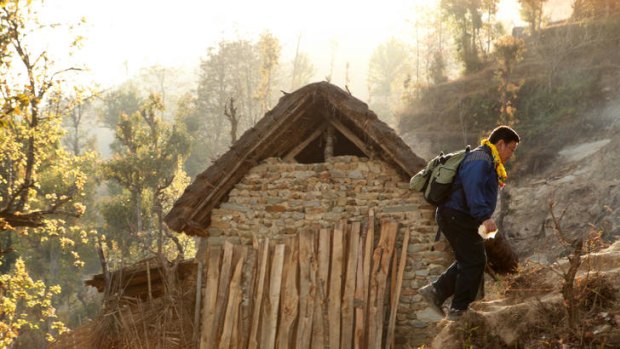
Hut call … ophthalmic surgeon Dr Sanduk Ruit visits the remote village of Manpur in Nepal.
We're following the ancient trail used by indigenous peoples walking north to Tibet, passing through some of the least visited - and most ethnically diverse - regions in Nepal. Tamang, Newar, Thami, Sherpa, Yolmo and Majhi people have all carved small, stepped farms into the sides of the valleys and promontories that mark the divide between two mountain ranges: the Himalayas to the north, the rolling Mahabharat to the south.
But our reason for being here, in Ramechhap district, has little to do with the scenery. Dr Sanduk Ruit, our host, is a Nepalese ophthalmic surgeon, veteran of 100,000 operations and a pioneer of small-incision, sutureless - and therefore self-healing - cataract-removal and lens-replacement surgery. He has assembled a small group of six to experience for themselves just how remote and difficult this terrain is for the able-bodied, let alone those who walk for days, without eyesight, to submit to his scalpel in the hope of being able to see again.
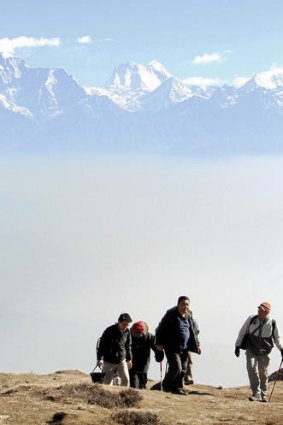
Sight for sore eyes … Ruit and three medical colleagues on the breathtaking two-day trek through the Himalayan foothills to Manpur.
Ruit met Australian ophthalmologist Professor Fred Hollows in Nepal in the early '80s and later came to Sydney to study at the Prince of Wales Hospital. Hollows recognised that, even as a young surgeon, Ruit's speed, dexterity and precision were matchless. The two were close and, to this day, 19 years after the death of his friend, Ruit remains a maverick who refuses to allow a sceptical medical establishment to stymie their shared dream of providing cheap, efficient - and, importantly, top-class - eye surgery to the developing world. Now, there is talk that this man, who operates barefoot, may soon be nominated for a Nobel Prize.
Ruit's plan is to walk us for two days into the mountains, through lush rhododendron forest, along dusty tracks and hillside farms into Manpur, a remote village where a forward party from his Tilganga Institute of Ophthalmology in Kathmandu, a team of nurses and an anaesthetist, will have set up a makeshift operating theatre in the village schoolroom. There, two visiting surgeons will observe Ruit's technique and, under his guidance, employing a second microscope used for cataract-removal surgery, share operating shifts. Together, they plan to successfully treat more than 130 villagers.
In the Tilganga Hospital the day before we left, Ruit had gestured to the noise and crowd of patients in the corridor outside and breathed deeply, almost with relief. "I'm a different person when I get out of here," he said.
Striding up the endless stone stairway into the sky on day one, Ruit's Sherpa constitution is unmistakeable. His steady lope looks slow from afar but, up close, it's almost impossible to keep up with him. His footfall is as powerful and reassuring as the enormous stone boulders that surround us.
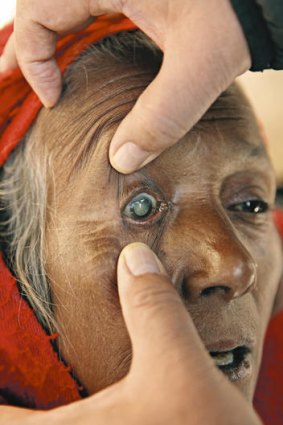
Open wide … a woman with very visible cataracts is prepared for surgery at Manpur.
The steep ascent renders our loquacious group speechless, the only sounds we hear our own rasping breath and the crunch of boots on frosty stone. The hillsides, cloaked in an early mist, soon reveal thick forests of mature rhododendrons already covered in buds and soon to erupt into a mass of blood-red, delicate-pink and snowy-white blooms. Coming round a corner, we find a fragrant copse of daphne flowers. Ruit is in his element, pointing out flora, birds, a Himalayan hawk circling high above our heads. The valleys below are deep, the stairs and upward track relentless, but the vastness of the surrounding scenery is elating. Our trio of young porters, all with at least 25 kilograms strapped to their backs, pause for a breather every now and then, backing up against specially created two-tier stone ledges.
For a while, a couple of handsome Himalayan dogs follow us, one - a pup - proudly trailing a goat's hind leg, complete with hoof, from his mouth. Just as it seems we can climb no higher, find no more air in our heaving lungs, the land flattens dramatically and a cluster of mound-like stupa, Buddhist memorial structures, emerges in silhouette on the bare, stony hilltop ahead of us. A green tin sign, leaning at a 45-degree angle, declares: "Sailung, 3146 metres." Prayer flags flutter in the wind.
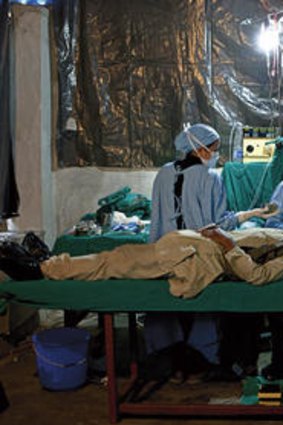
Delicate operation … Ruit works in the temporary operating theatre in a school in Manpur.
But it is what lies beyond that takes our breath away: 360 degrees of snowcapped mountains - the Annapurna peaks to the west, Kangchenjunga in the east, with Everest, iconic and forbidding in her beauty, in the centre.
"There is a time of year when the sun is at a specific angle and the light falls in a way that creates the perfect view," says Dr Ruit quietly. "The Tamang are the dominant community here. They lead very difficult, very tough lives. They are, by and large, subsistence farmers, Buddhist, and for them this is a very auspicious place."
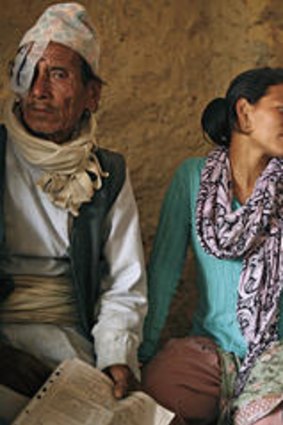
The look of love … 22-year-old Sudip Lama and his wife of two months, Kamala.
As we set off on the long trek down, bound for our halfway point of Doramba, I ask Ruit, now 57, if he can remember his first walk in the Nepali mountains.
"I was born in a very small and remote village in Olangchungola Pass in north-eastern Nepal. I was about seven and I vaguely remember holding hands with my mother and she was crying," he says as I settle into a trot beside him. "My father took me and we started on the back of a truck for a half a day. The nearest school was more than a week away. We walked for days over the mountains to Darjeeling in India, where he left me at St Robert's, a missionary school.
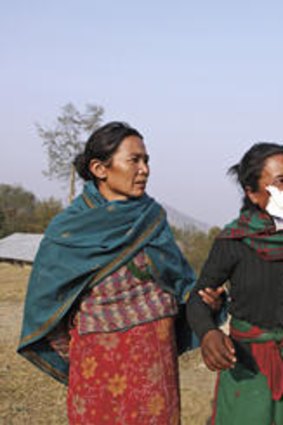
Healing touch … 20-year-old Ramsali Lagu Maya touches Ruit’s nose on command after her eye patches are removed.
"I hated the holidays because everyone else went home. I stayed at school with Father Mackey; often it was just him and me left. I remember getting sick, the chicken pox, and having a large abscess drained. It was very tough, very lonely. Between the ages of seven and 13, I think I went home only twice."
The family's enormous distance from medical help was responsible, ultimately, for the loss of Ruit's elder brother to severe diarrhoea and the death of a younger sister from tuberculosis. Witnessing the end of her life had a dramatic effect on the young Ruit's childhood ambitions: he would become a doctor instead of a pilot. When the Sino-Indian War broke out in 1962, he was forced to move - this time back to Nepal and high school in Kathmandu, where he found himself, once more, alone. It was from here he won a place to study medicine at the prestigious All India Institute of Medical Sciences in New Delhi.
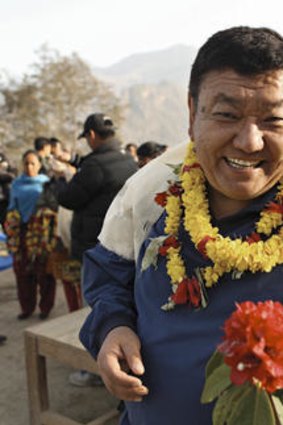
Man of vision … Dr Sanduk Ruit wears flowers given as thanks for his work.
Three decades on, Ruit has trained close to 1000 young surgeons from all over the world in the techniques he uses. The Tilganga hospital, funded in part by the Fred Hollows Foundation (to the tune of $9 million since 2000) employs 300 Kathmandu locals and is now globally renowned. Today, its Fred Hollows Intraocular Lens Laboratory manufactures 350,000 lenses every year at a cost of just $US3.50 each. Making one for $100 was once considered a pipedream and those, like Ruit and Hollows, who believed it could be done cheaply - and used to restore sight to those in the developing world - were laughed at by the medical establishment. The Fred Hollows Foundation continues to fund eye camps, equipment and training; the deep friendship between the two eye surgeons was a long-time financial partnership, too.
Ruit's surgeons ply their craft, on rotation, in inaccessible areas of Nepal throughout the year. Without fail, he treks in and performs some of the surgery himself. "Yes, the walking is part of the joy," he says, "but it's important to really know your patients, to understand how they live and what it is that they need.
"Eyesight is so important for people in this part of the world. There is no support for the blind. No benefits for those affected. For me, it is now about spreading the word, showing the technique and proving local surgeons can do it. It's not expensive and we can slow the impact of blindness."
Is there anything at all that dampens your optimism, I ask? Ruit pauses. "The lack of compassion in others," he says.
Night has fallen and we are staying in the home of a local teacher in the halfway village of Doramba. It feels like the Hilton. With our feet and legs aching with lactic acid and fatigue, we settle down to an unforgettable feast of smoke-dried buffalo, freshly picked Himalayan spinach, tiny potatoes grown in the terraces around the village and hot lentil dhal. It's all washed down with black Nepali tea, sweetened and laced with pepper. Later, sleeping three abreast, we are toasty-warm and the facilities we are all so used to - toilets, pillows, electricity - seem to belong to another world.
A second Himalayan dawn breaks and hot tea and freshly made Nepalese pancakes appear, which we wolf down with hard-boiled eggs and noodles. Our legs are given a few hours reprieve when Dr Ruit reports that the forward party, including his nurses, have been delayed and we shouldn't yet set out to meet them. Much later, we learn that the team was temporarily stranded, thanks to a faulty steering column, on a remote and treacherous mountain road.
At midday, we don our packs and set off again, this time descending steeply into the valley below. Ruit, striding out steadily, recounts his years as a medical student and the hours and hours he spent, alone, locked inside his medical school's laboratories on the weekends, taking advantage of monkeys tranquillised with Nembutal to study their eyes with a fortuitously discovered Zeiss microscope.
"I spent hours, days, weeks working on it," he says. "That period was very lucky for me. It is how I learned to become familiar with looking through a microscope and to get used to, and practise, the specialised hand-eye co-ordination you need for microsurgery.
"I believe in destiny, in good luck," he continues. "If your intentions are right, you will have the right experiences, meet the right people."
As we walk, slide and occasionally tumble down the slopes, Ruit attempts to describe the special technique he uses to remove cataracts in his patients, using an egg as an analogy: "Imagine the eye as a boiled egg and the cataract as yolk. We make a tiny incision in the shell and remove the yolk. We use a probe to break it up with ultrasound and then suction it out, all without destroying the shell. Then, into the intact eye we put a new lens. The incisions are tiny - small, self-sealing flaps - so no stitches.
"I remember so many patients, their faces afterwards, but there was one, a lady of 60 or 65 perhaps, who started to giggle when I checked her cornea the day after the operation. I asked her, pointing at her husband, 'Who is this man?' and she said, 'He's my man and he looks more or less the same ... just more wrinkles.' She hadn't seen him for 15 years. He smiled and smiled."
We arrive in Manpur at sundown, exhausted. More than 100 patients, most of them elderly, are sitting waiting on long benches in the fading sun. All are holding a piece of paper, their ink thumbprints their only ID, and all have the cloudy, milky stare that sees little beyond light and shade.
The Nepalese have a natural elegance. They are lean and sinewy and everyone, despite their blindness, exudes a stoic toughness. Khem, the Tilganga hospital's indefatigable logistics man, tells us there are about 130 people here who will require surgery; the majority have been screened and measured for lens size in the past few hours.
Most have travelled for days - either on foot, piled into a rickety truck, or on the backs of younger relatives - to see Dr Ruit. This is word-of-mouth medicine, passed on via paper signs on trees, radio messages, visiting nurses and, most importantly, by others who have undergone the surgery and can now see.
Tents for the medical team have been erected, a makeshift kitchen has been set up in a shed and the two biggest buildings have been scrubbed and lined with plastic. Inside the operating theatre, two microscopes are in place - one at the head of one gurney, the other, Ruit's, positioned between two beds that have been arranged head to head. This is a testament to his speed.
As night falls, huge plastic pails of lentil soup are taken to the patients, who drink it up as if it were nectar of the gods. Most have brought their own blankets and settle into whatever spot they can find for the frigid night ahead. We rest fitfully, wondering just what we will see in the morning and how our First World sensibilities will respond.
The next day, the surgical assembly line is in gear and under way by 8.30am. Outside the anaesthetic room, patients are lined up on benches. Volunteers place patients' dusty, bare feet into plastic bags and tie them tightly in an effort to curtail the movement of dirt during surgery. Bottles of Xylocaine are lined up in piles as the anaesthetist begins his work. The needles, which look enormous, are plunged directly behind the eye to block the nerves for cataract removal. It is a confronting sight: the eyes have already had their eyelashes cut off and look horribly exposed. What is memorable is the quiet dignity with which every single patient endures the procedure. "It is very, very painful," Khem says matter-of-factly. Only one young man, just 22 years old, newly married and with congenital cataracts in both eyes, vocalises his pain. It's a low, contained moan but its meaning is unmistakeable.
Inside the theatre, Ruit is scrubbed, gowned and visibly barefoot. Nepalese music plays softly on the iPod behind him and, as I settle in behind his left arm to watch him perform his first procedure of the day, he talks me through every slice and poke and tug into the eyeball as the tiny probe first breaks up the jellyish grape that is the cataract and then replaces it with a new plastic lens. He has disinfected and patched the eye and moved on to his next patient inside seven minutes.
Cataract blindness affects some 40 million people worldwide; three out of four of them can be cured by way of a simple operation. It has been estimated that up to four million patients have had their cataracts treated using the technique Ruit teaches; in just a day and a half here, 131 people, subsistence farmers all, have been given back their lives.
The following morning, the three surgeons do their "rounds" outdoors. Torches check responses, corneas are examined for redness, antibiotic drops are administered and aftercare instructions are explained.
The only two youngsters in a predominantly elderly group sit quietly waiting to be seen. Ramsali Lagu Maya is just 20, the daughter of a single mother who wants nothing more for her than independence. Ramsali wants to tend a herd of goats. Just 24 hours before, her eyes stared vacantly, but after Ruit has removed her patches, this very serious, almost non-responsive girl grins. "Touch my nose," says Ruit and, with precision, she reaches out and does so.
Nearby, 22-year-old Sudip Lama is sitting quietly with his wife of just two months, Kamala. They are a good-looking couple and we joke, with the black humour born of tough situations, that it's lucky his wife is pretty or he might want his cataracts back. When the two clap eyes on each other, reach out and hold hands, my throat constricts with emotion.
"We are getting the same kind of post-operative results as the best teaching hospitals in the world, but under the most challenging conditions imaginable," says Dr Ruit. "You've seen that now."
And so have his grateful patients.
Paola Totaro and photographer Penny Bradfield travelled to Nepal courtesy of the Fred Hollows Foundation.